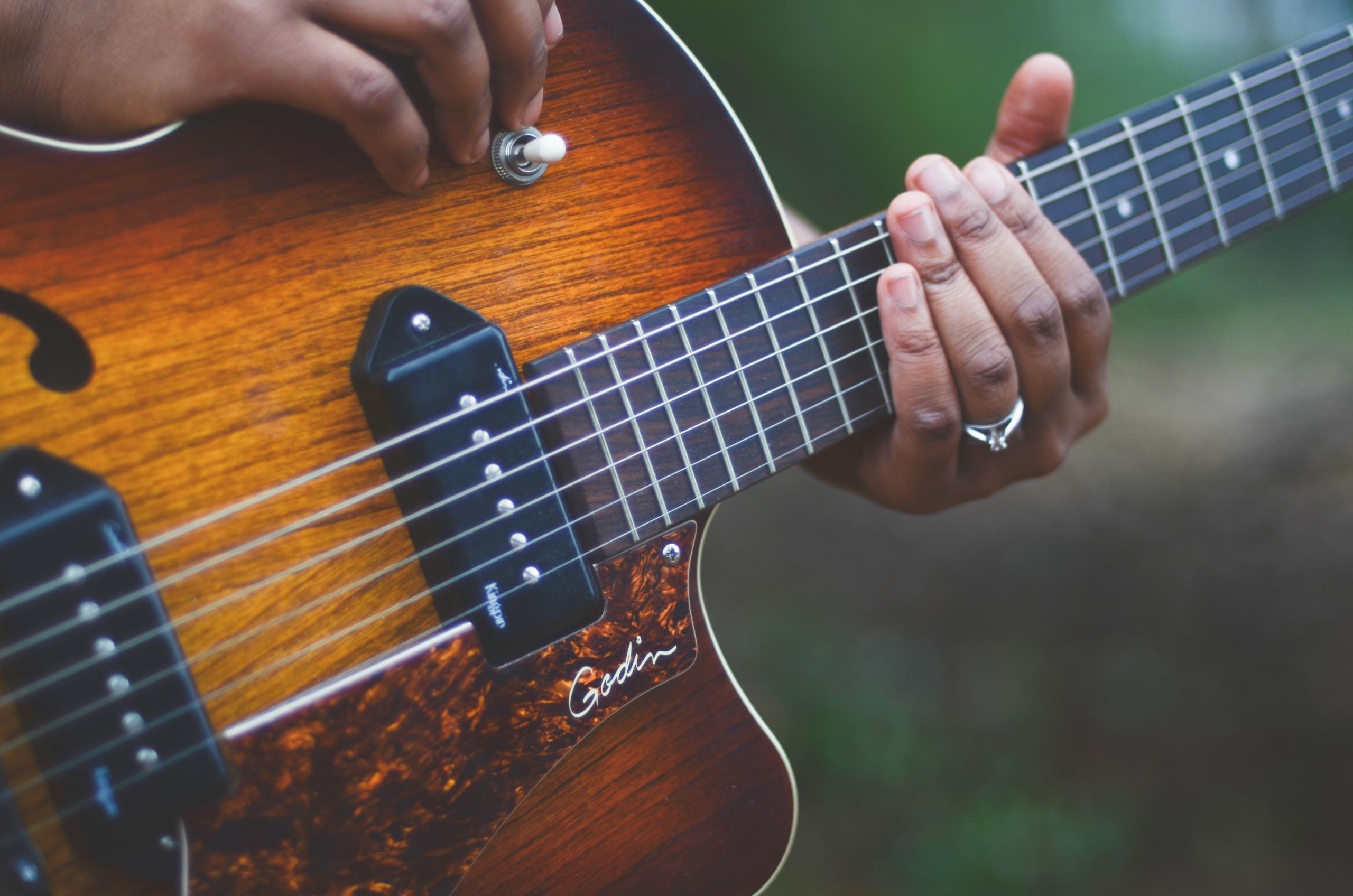The term "lead guitar" describes a particular kind of guitar playing that is typically done by the lead guitarist in a band. Guitarists in a group have several tasks. It's critical that these positions are clearly defined because they each have a part to play in contributing to the total. The most typical combination in guitar-based music (rock, country, blues, indie, folk, etc.) consists of three guitar players. There are no ultimate laws in music, and there are an endless number of ways to mix musical roles.
The bass guitar holds things down with powerful low-end beats. The bass guitar comes with large notes, hardly any chords, and just four strings. In contrast to lead guitar, the rhythm guitar's focus is mainly on chords and strumming. Contrary to the rhythm guitar, the lead guitar's focus is typically on single-note lines and melodies (riffs, licks, solos, etc.). But chords are still significant.
Learn all about guitar with online guitar classes.

The Lead Guitar: What It Means
Although tearing into a solo in the middle of the song is the lead guitarist's most noticeable job, the position involves much more than simply solos. You must master contributing throughout an entire song if you want to learn how to play lead guitar. not just the solo, either! A lead guitarist can enter and exit a tune with melodic lines and complimentary moments that greatly enhance the music.

Observing the most popular Indian lead guitarists is a terrific approach to learning how to play lead guitar. This offers motivation and suggestions. Watch it intently and take notes—do not just let the performance wash over you! You'll notice stuff you like, which you can subsequently pick up. Learning to play lead guitar can seem difficult, but it's really enjoyable and you simply need to break it down into smaller, more doable steps, like with any endeavor.
Guitar Techniques!
There are several benefits to learning the guitar. For some, it represents a challenge. Some individuals take pleasure in mastering the guitar solos from their favorite tunes. When performing in a band and their solo appears during the song they are playing, some people relish their moment in the limelight. Whether it's with their pals or over music, some folks genuinely like improvising.
Playing the lead guitar is particularly characterized by a number of guitar-playing methods and traits. These may overlap with rhythm guitars, however, lead and rhythm guitarists can utilize these techniques for different things. Guitar solos, licks, riffs, arpeggios, and alternate or tremolo picking are some of the most crucial techniques employed by the most popular lead guitarists in the world, across a variety of genres, from rock to blues and heavy metal to jazz. There are simple examples and ways in which even novices can start learning how to play lead guitar, even though many of these approaches may seem frightening and difficult when listening to or watching experienced lead guitarists play.
Riffs and Licks
Licks and riffs are two ideas that go hand in hand and aren't just for lead guitar. In essence, a lick is a brief melodic concept typically played on high-pitched strings, whereas a riff is a repetitive pattern typically played on low-pitched strings. One argument given for the distinction between guitar riffs and licks is that a riff is associated with a particular song, whereas a guitar lick may be applied in several situations. A guitar lick would be an instance of stealing just a little piece of a few notes from the song's opening solo and using it in your own tune.
Solos
The lead guitarist, in any band, with a distinct lead and rhythm guitarist, is in charge of performing solos. Guitar solos are a fantastic opportunity to showcase your mastery of the instrument and dazzle listeners. Even the lead guitarist's singing is put on hold during a guitar solo as they take center stage. Additionally, solos are a fantastic method to demonstrate your improvisational abilities if you have the talent to create the solo on the spot.
Arpeggios
An arpeggio is a particular kind of broken chord in which the individual notes that make up the chord are played in descending or ascending order rather than all at once. A little more complex technique is employed when playing guitar arpeggios during solos. Sweep picking is a more complex method for playing arpeggios on the guitar, where you "sweep" the strings with your picking hand while fretting the notes with your fretting hand. Sweep-picking examples can be heard in a variety of musical styles, including jazz. It is, however, most frequently utilized in heavy metal and other types of rock guitar solos.
Learning How to Play Lead Guitar
Contrary to what a lot of people think, you can learn to play the guitar on your own! Some individuals could tell you it's not a good idea, while others might overtly dissuade you from giving it a shot. Forging your own route is always a good choice, even though having a wonderful teacher and a mentor who's dedicated to helping and guiding you through the learning process is incomparable.

Studying several approaches is necessary to learn lead guitar. Many beginners also find that learning a little bit about music theory is quite helpful. Lead guitarists should at the very least learn ornamentation techniques, two-string sweep picking, and economy picking. The major and minor scales with three notes per string are where these picking techniques work best. The minor pentatonic scale should also be studied because many rock and metal solos are built using this scale. By matching the solo's patterns to the scale, you can master your favorite solos more quickly.
Studying ornamentation techniques, such as bends, pre-bends, legato (pull-offs and hammer-ons), vibrato, slides, and, will be helpful if you want to play lead guitar. You should next learn to combine these ornamentation approaches by integrating those skills with playing through 3 notes per string scale patterns. Other musical genres that may be beneficial for aspiring lead guitarists include:
- Arpeggios
- Synchronized major-minor scales
- Tapping
- Rhythms
- Ornamentation like staccato and rubato
- Melody with non-harmonic tones
Scale-Based Approach to Playing Lead Guitar
The majority of people approach the lead guitar in this way. Use a scale suited for the key in which your chord progression is in order to determine what key it is in. This is where having a rudimentary understanding of music theory is very helpful. You will know which minor scales to employ over those chords when you play chords in minor scales. Alternatively, you could play the A minor pentatonic over the A minor chord, the D minor pentatonic over the D minor chord, and the E minor pentatonic over the E minor chord. This is the second strategy.
Composition Approach to Lead Guitar
The second strategy is to use the melodic composition principles while you're playing. This requires far more work than the scale-based method we looked at previously, but the end result will be musically richer. Learning your five-string arpeggios is a fantastic place to start, after which you can consider how to combine non-harmonic tones with those arpeggios. Scales with three notes per string can then be added on top of it. It may take some time to complete, but if you persevere, you will master some amazingly expressive musical techniques.
Learn all the techniques you need to know with guitar classes Pune on Superprof.
Composing Lead Guitar
In composition, you can use the same techniques you use in improvisation, but you have a little more time to consider the notes you are picking. When writing lead guitar solos, it's a typical error for guitarists to use only 16th notes throughout the entire solo. While a random 16ths run might be incredibly fantastic, too many can become monotonous.
You may create a melody that is significantly more expressive than a solo made entirely of 16th notes by learning how to employ rhythm to create motifs, which you then develop into musical functions and themes. Making sure your melody has enough ornamentation is also crucial since ornamentation transforms your lead guitar playing from sounding like a collection of scales into a singing instrument.
Picking Lead Guitar
The two main methods for lead guitar picking are:
- Alternative Picking
- Economy Picking

In economy picking, it is to move the pick between strings, as you always start the next string in the direction that the pick is already moving in. Alternate picking involves strictly playing “down up down up” no matter the direction that the pick is moving in. Some lead guitarists prefer economy picking for its ease, and others prefer alternate picking, claiming that it gives a better attack.
Like any other skill, mastering lead guitar requires time and repetition. There are practically countless lead styles, tricks, scales, and methods. A lead guitarist that is well-rounded will be familiar with the fretboard and the CAGED system so they can play chord voicings that are different from those used by the rhythm guitarist. The melodies, solos, fills, and other flourishes that give a song its style and intricacy are typically played by the lead guitarist. Contrast this function with the rhythm guitarist, who usually supplies the song's rhythmic and structural framework.
Every lead guitarist should start by honing their technical abilities, which is typically done by practicing scales, paying careful attention to a metronome, and learning some fundamental music theory so they can comprehend how to use those scales in various musical contexts. There are various methods you might go about doing this. The two most common methods include a teacher or a course. An excellent instructor will offer suggestions. A quality course will provide structure, break down complex concepts into manageable chunks, and keep you on track over the long haul. Whichever strategy you choose, it's critical to realize that this is a lengthy process that needs attention every day.
Ensure that you learn everything you need to know by enroling in guitar classes here on Superprof!
















